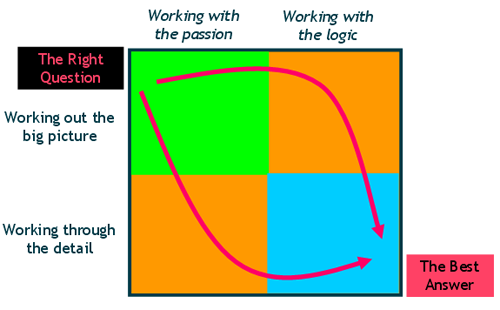How much of your thinking is logical and rational? How much of it is influenced by emotion and swayed by the way you feel?
The 'emerging' area of neuroleadership suggests that every single decision not only reflects our instinctive reaction to an issue, it contends that when faced with something to think about - whether a question, proposition or challenge - all of us begin to respond unconsciously at an emotional level before layering more logical analysis on top. How is this going to affect me? What will I gain or lose? Does it fit with what I have said or done before? What will other people think or do? We often don’t articulate these questions to ourselves but our brain worries about them anyway.
So in physiological terms, we seem to begin processing our responses deep in parts of the brain which were some of the first to evolve, such as the Amygdala, before engaging those higher brain functions, like judgement, problem solving, impulse control and reasoning, which are located in the frontal lobes.
Neuroleadership attempts to apply an increasing understanding of how the brain works (using new imaging techniques) to the management field. The implications for complex problem solving, decision making, managing expectations, influencing each other and employee retention are some of the areas being explored. (see http://www.businessweek.com/magazine/content/07_30/b4043084.htm)
There is even an annual summit on it (see http://www.neuroleadership.org/gmm_menu_page.jsp?menu_id=16)
One of our ‘mentors’, Arie de Geus, who was a senior executive at Shell, helped pioneer their scenario planning work and wrote a great book on business success (The Living Company), believes the learning in this area will have a big effect on how organisations take decisions and then put these into practice. It could be that the Board room is the best place to start.
Accepting that we always react at an emotional level, however rational we think we are, can be a hugely helpful key in helping understand ourselves and in influencing others. How do you feel about that?
This month’s letter is R for Reactions.
In our work we often spend time with senior and other teams using our rapid team diagnostic approach. Everyone completes a number of cards exploring individual views on a number of key management and personal development theories. After pairs have summarised them the group discusses the results. Two of these quickly digested frameworks are particularly popular (and can be easily researched on Google). Both are well known. One is Edward de Bono’s Six Thinking Hats. The other is the BBC version of Myers Briggs Type Indicator. One aspect that is often discussed is the degree of emotional engagement of senior leadership groups in the issues and problems they are dealing with. This connects with the Red hat and the Thinking-Feeling (head-heart) preference.
This month we share a test we developed many years ago to help individuals think about (and manage) their emotional reaction to situations. We believe that awareness of our individual responses helps us be a better part of the teams and groups (and families) we are part of: www.idenk.co.uk/reactions
In our work with NHS clients, the theme of compassion continues to grow - and we see more and more signs of the movement for greater care and kindness
in health services around the world. Learning how to increase or revive empathy in the work of health sector managers, clinicians and staff is an important theme. Some have never found empathy easy. Others have become burnt out. We are enormously encouraged in what we are noticing. We are happy to share more – do drop us a line at think@idenk.com.
Our matrix this month is one that we’ve evolved in experimenting with how best to work with teams in collaborative decision-making. It emphasises the need to work with how people feel about things as well as the logic of the issue. You also need to make sure that you’ve stood back to see the big picture (how ‘out there’ will affect what you’re doing) and get to sufficient detail that you can see how you will translate thinking into effective action. Too often teams don’t get anywhere because they haven’t worked through the specifics on what, who, how and when.

We’ve suggested one combination of paths that you might take in getting from the question facing you to the best answer. At the very least, making sure you deal with all 4 quadrants is a great check to make sure you haven’t missed anything big!
We like to take a creative approach to surfacing the opinion of individuals in small and large groups. We use voting methods from the simple (hands up, thumbs up) to the playful (balls in buckets, stay standing if…) through the colourful (our voting cards) to the technological (web surveys, electronic voting).
You can learn more about our cards here and how you can get some for your own team:
www.idenk.co.uk/facilitation
And as usual, we would love to know what you make of this month’s newsletter.
Ross and Phil at think@idenk.com
If you missed the previous editions of our newsletter, you can find them here.
Sign up for updates on our latest thinking via the Business Briefing